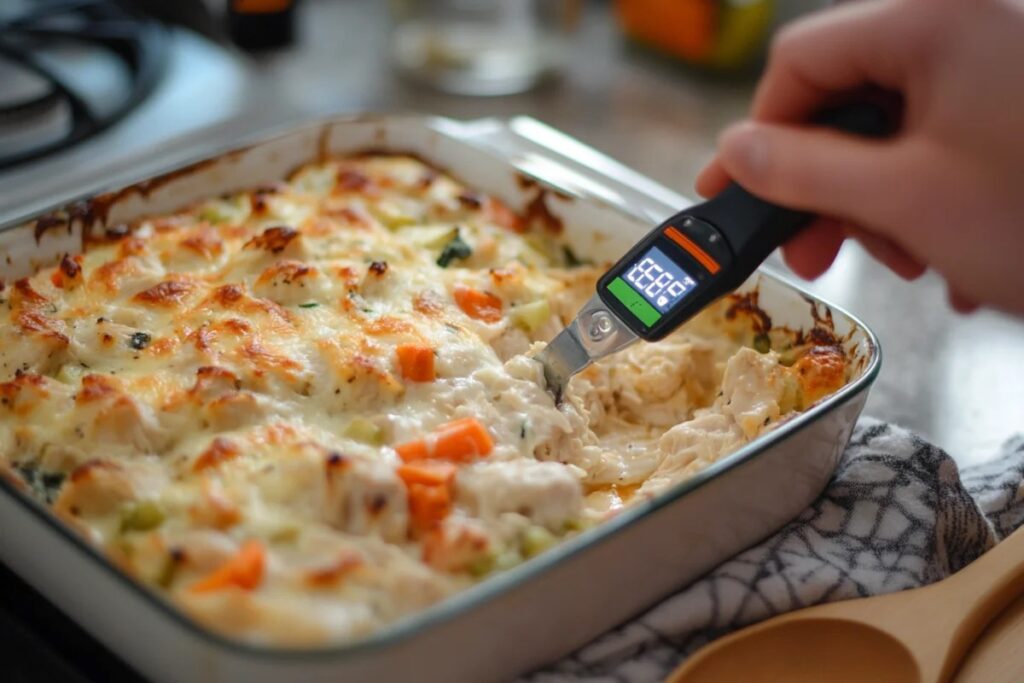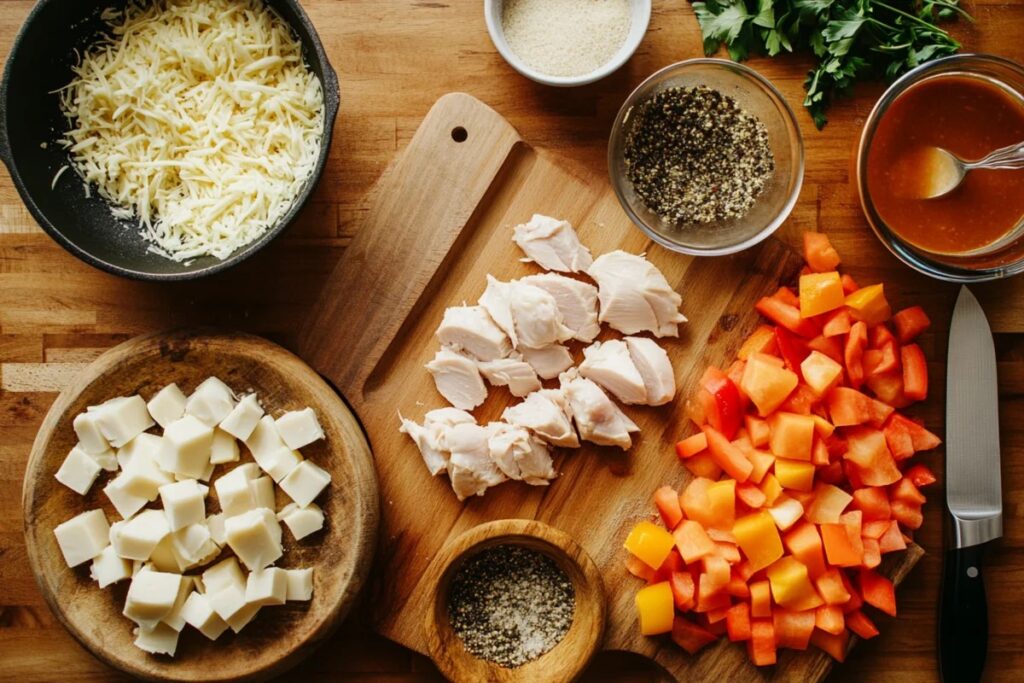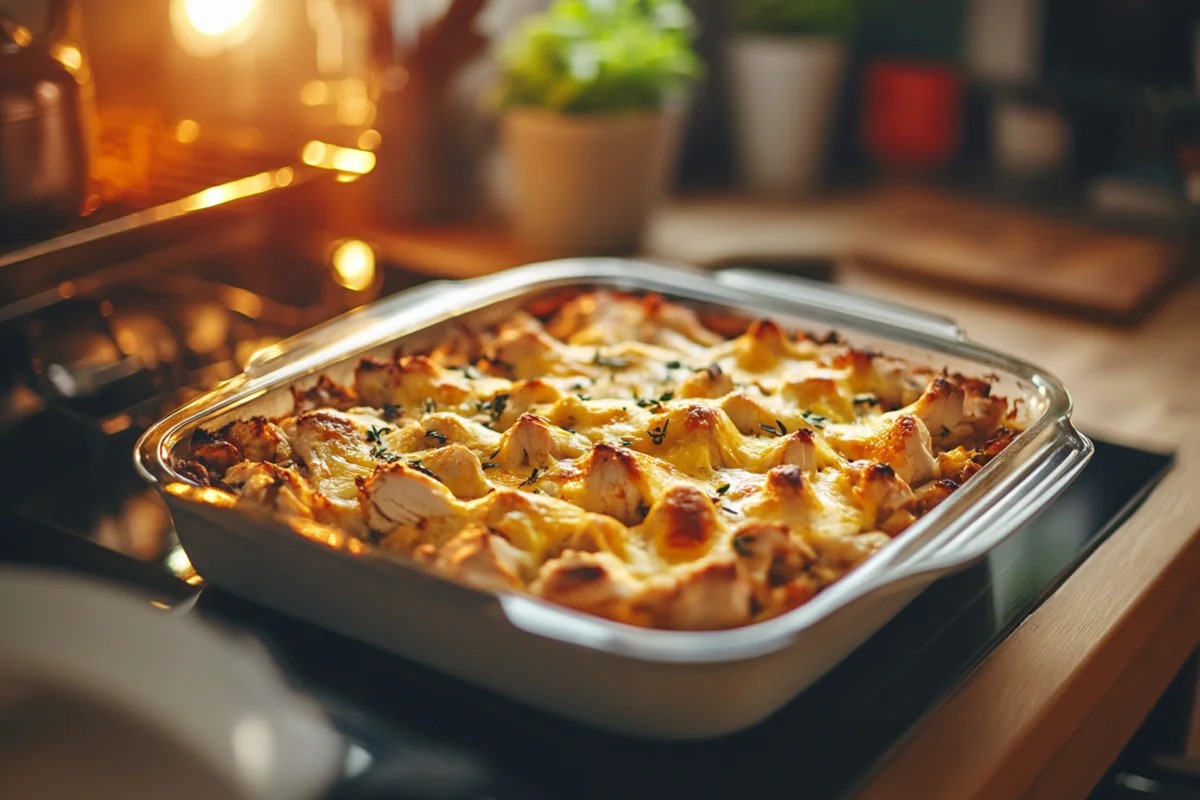Casseroles are a go-to comfort food hearty, flavorful, and incredibly easy to prepare. But one question often sparks debate among home cooks: Is it okay to put raw chicken in a casserole? Some argue that the long cooking times ensure the chicken is fully cooked, while others worry about safety risks like undercooking and cross-contamination.
This article dives deep into whether using raw chicken in a casserole is safe, what precautions to take, and the best cooking methods to ensure a delicious and risk-free meal. We’ll also explore alternatives like pre-cooked chicken, bust common myths, and answer frequently asked questions. Let’s get started!
Print
Is It Okay to Put Raw Chicken in a Casserole?
A hearty, one-pan chicken casserole made with raw chicken, vegetables, and a creamy sauce—perfect for busy nights.
- Total Time: 75 minutes
- Yield: 6 servings 1x
Ingredients
2 lbs raw chicken breast, cubed
3 cups diced potatoes
1 cup chopped carrots
1 cup green peas
1 cup shredded cheddar cheese
1 can cream of mushroom soup
1/2 cup milk
Salt and pepper to taste
1 tsp garlic powder
1/2 tsp paprika
2 tbsp olive oil
Instructions
1. Preheat oven to 375°F (190°C).
2. Grease a 9×13-inch casserole dish with olive oil.
3. Layer potatoes, carrots, and peas at the bottom.
4. Add cubed raw chicken evenly across vegetables.
5. In a bowl, mix soup, milk, and spices. Pour over the chicken.
6. Top with shredded cheese.
7. Cover with foil and bake for 45 minutes.
8. Remove foil and bake another 15 minutes until golden and bubbly.
9. Check chicken temperature—it should read 165°F.
10. Let rest 5 minutes before serving.
Notes
You can substitute cream of mushroom soup with cream of chicken or a homemade white sauce.
Ensure even cutting of chicken and vegetables for uniform cooking.
- Prep Time: 15 minutes
- Cook Time: 60 minutes
- Category: Casserole
- Method: Baking
- Cuisine: American
Nutrition
- Serving Size: 1 cup
- Calories: 410
- Sugar: 3g
- Sodium: 720mg
- Fat: 22g
- Saturated Fat: 9g
- Unsaturated Fat: 12g
- Trans Fat: 0g
- Carbohydrates: 22g
- Fiber: 3g
- Protein: 29g
- Cholesterol: 110mg
Introduction to Cooking Raw Chicken in a Casserole
What is a Casserole?
A casserole is a one-dish meal typically made by combining proteins, vegetables, starches (like rice or pasta), and a flavorful sauce. The ingredients are baked together in an oven, creating a hearty and cohesive dish. Because casseroles are slow-cooked, many assume that raw ingredients—including chicken—can be safely added and cooked together.
Why People Consider Using Raw Chicken in Casseroles
Using raw chicken in a casserole seems like a time-saving trick. After all, it eliminates the extra step of pre-cooking the chicken, which can be a hassle. Many recipes suggest layering uncooked chicken with other ingredients, assuming that everything will cook evenly by the time the dish is done. Plus, cooking everything together allows the chicken’s juices to enhance the overall flavor.
Addressing Common Safety Concerns
While using raw chicken in a casserole is common, it’s not without risks. The biggest concern is foodborne illness, particularly Salmonella and Campylobacter bacteria, which can thrive in undercooked poultry. Another issue is cross-contamination—if raw chicken comes into contact with other ingredients before reaching a safe temperature, bacteria can spread.
So, what’s the verdict? Can you safely cook raw chicken in a casserole? In the next section, we’ll break down the facts, safety guidelines, and expert advice. Stay tuned!
Can You Put Raw Chicken in a Casserole?
Understanding the Safety of Cooking Raw Chicken in Casseroles
Many home cooks wonder: Is it okay to put raw chicken in a casserole? The answer is yes—but only if done correctly. Cooking raw chicken in a casserole is generally safe as long as the dish reaches an internal temperature of 165°F (75°C). The key is ensuring that all ingredients, especially the chicken, cook evenly.
The Role of Cooking Temperature and Time
Baking temperatures for casseroles typically range between 350°F and 400°F, but not all ingredients cook at the same speed. Dense foods like potatoes or rice may take longer, potentially leading to undercooked chicken if not planned properly. Using a meat thermometer is the best way to confirm that the poultry has reached a safe temperature.
If you’re working with a casserole that contains dairy or a thick sauce, ensure that the dish cooks long enough for the chicken to absorb heat thoroughly. Covering the casserole with foil can help distribute heat evenly, but always uncover it near the end for a crispy top layer.
USDA Guidelines on Cooking Chicken in Mixed Dishes
The USDA Food Safety and Inspection Service states that raw chicken is safe in dishes as long as it reaches 165°F internally. However, they emphasize the risk of cross-contamination—raw chicken juices can spread bacteria to other ingredients if not handled correctly.
To minimize this risk:
- Keep raw chicken separate from fresh vegetables before baking.
- Wash hands and surfaces after handling raw meat.
- Cook casseroles long enough to ensure all ingredients are thoroughly cooked.
While it’s possible to add raw chicken directly, safety depends on proper handling, cooking time, and temperature control.
Risks of Using Raw Chicken in a Casserole
The Risk of Undercooked Chicken and Foodborne Illness
One major concern when using raw chicken in casseroles is foodborne illness. Bacteria like Salmonella and Campylobacter can survive in undercooked poultry, potentially leading to food poisoning. Symptoms can range from mild stomach discomfort to severe gastrointestinal issues.
A common mistake is assuming that if the casserole is bubbling, the chicken is fully cooked. However, bubbling sauce or melted cheese does not indicate doneness. The safest way to ensure proper cooking is to use a meat thermometer. The internal temperature must reach at least 165°F at the thickest part of the chicken.
Cross-Contamination Risks in Casserole Preparation
Cross-contamination is another serious risk when handling raw chicken. If raw poultry comes into contact with other ingredients—such as vegetables, pasta, or cheese—bacteria can spread before the dish even goes into the oven.
To prevent contamination:
- Use separate cutting boards for raw chicken and other ingredients.
- Wash hands immediately after touching raw chicken.
- Sanitize kitchen surfaces to eliminate bacteria.
It’s also wise to avoid adding raw chicken on top of pre-cooked ingredients, as uneven heating can leave certain parts undercooked.
How Bacteria Spread in a Dish with Multiple Ingredients
Casseroles often contain dairy-based sauces, pasta, and vegetables, which may not require as much cooking time as chicken. This imbalance can create a problem—if the chicken isn’t fully cooked, it can transfer bacteria to the entire dish.
To avoid this:
- Cut chicken into smaller, uniform pieces for even cooking.
- Increase baking time if using raw chicken.
- Use foil or a casserole lid to trap heat and prevent uneven cooking.
While it’s technically safe to put raw chicken in a casserole, extra care is needed to ensure it’s thoroughly cooked. Otherwise, you could end up with an unsafe meal.
Proper Cooking Techniques for Raw Chicken in Casseroles
Ensuring the Internal Temperature Reaches 165°F

One of the most crucial steps when cooking raw chicken in a casserole is making sure it reaches a safe internal temperature. The USDA recommends that chicken be cooked to 165°F (75°C) to eliminate bacteria like Salmonella and Campylobacter.
To ensure accuracy:
- Use a meat thermometer to check the thickest part of the chicken.
- Avoid relying on visual cues like bubbling sauce or browned cheese—these do not guarantee doneness.
- Let the casserole rest for a few minutes after baking to allow heat to distribute evenly.
Using a Meat Thermometer for Accuracy
A digital meat thermometer is the best tool to confirm your casserole is fully cooked. Insert it into the largest piece of chicken without touching the pan. If the reading is below 165°F, continue baking in 5-minute increments, checking frequently.
Here are additional tips for even cooking:
- Cut chicken into smaller pieces for faster, more uniform cooking.
- Avoid overcrowding the dish, as tightly packed ingredients may trap moisture and prevent proper heat circulation.
- Stir halfway through baking if the recipe allows, ensuring all pieces get evenly cooked.
Adjusting Cooking Time Based on Casserole Ingredients
Different ingredients affect baking time. If your casserole includes rice, potatoes, or dense vegetables, it may need a longer cook time than a dish with pasta or canned ingredients.
To balance cooking times:
- Pre-cook dense vegetables like carrots and potatoes before adding them to the casserole.
- If using raw rice, ensure enough liquid is included to cook it properly without drying out the chicken.
- Cover the casserole with foil for the first half of baking to trap steam, then remove it to allow browning.
Following these steps will help you safely cook a raw chicken casserole without compromising texture or flavor.
Alternatives to Using Raw Chicken in a Casserole
Pre-Cooking Chicken: Sautéing, Boiling, or Baking Beforehand
If you’re unsure about cooking raw chicken in a casserole, pre-cooking it is a great alternative. Sautéing, boiling, or baking the chicken first ensures it reaches a safe temperature before it’s mixed with other ingredients.
Here’s how different methods affect texture and flavor:
- Sautéing: Gives the chicken a slight crispiness and enhances flavor.
- Boiling: Keeps the meat moist but can make it bland unless seasoned well.
- Baking: Helps retain juices but can make the chicken drier if overcooked.
Using Rotisserie or Leftover Cooked Chicken
Another time-saving option is using rotisserie chicken or leftovers from a previous meal. This method reduces cooking time and prevents concerns about undercooked poultry.
Advantages of using pre-cooked chicken:
- Shortens casserole cooking time.
- Reduces risk of foodborne illness.
- Allows flavors to meld better, especially with creamy or cheesy casseroles.
If you opt for pre-cooked chicken, adjust the recipe to avoid overcooking:
- Reduce baking time by 10–15 minutes since the chicken is already cooked.
- Add pre-cooked chicken near the end to prevent it from drying out.
- Use a little extra sauce to keep the casserole moist.
Benefits of Pre-Cooked Chicken for Texture and Flavor
Using pre-cooked chicken not only improves safety but also enhances the final dish. Because the chicken has already been properly seasoned and cooked, it absorbs flavors better. Additionally, you can control texture, avoiding the risk of stringy or rubbery chicken.
If you’re looking for a delicious way to incorporate cooked chicken, consider this chicken and hash brown casserole for an easy and satisfying meal.
Best Practices for Safe and Delicious Chicken Casseroles
Choosing the Right Ingredients to Complement Chicken

When making a chicken casserole, picking the right ingredients can make or break your dish. If you’re asking, Is it okay to put raw chicken in a casserole? the answer depends partly on your ingredient choices. Ingredients like rice, beans, and root vegetables are perfect because they need a longer cooking time, just like chicken.
To enhance flavors, consider adding:
- Aromatic herbs like thyme and rosemary, which pair beautifully with chicken.
- Bold spices such as paprika or cumin for an extra kick.
- Cream-based sauces to keep the chicken moist and add richness.
Preventing a Watery or Undercooked Casserole
No one likes a soggy casserole! When using raw chicken, excess moisture can be an issue. To avoid this, here are a few tips:
- Pat chicken dry before adding it to the dish. This helps it roast instead of steam.
- Use thickening agents like a tablespoon of flour or cornstarch mixed into the sauce.
- Bake uncovered for the last 10–15 minutes to allow excess moisture to evaporate and create a golden, crispy top.
Covering vs. Uncovering the Casserole During Baking
Deciding whether to cover your casserole can influence the final texture. If you’re working with raw chicken, start by covering the dish with foil. This traps heat and ensures everything cooks evenly. However, for the last part of baking, remove the cover to let the top brown and the sauce thicken.
For dishes with cheese or breadcrumbs, uncovering helps achieve a delightful crust. Just keep an eye on it to prevent burning!
Common Myths About Raw Chicken in Casseroles
Myth: Raw Chicken Always Cooks Evenly in a Casserole
One widespread belief is that raw chicken will always cook evenly in a casserole. Unfortunately, this isn’t always the case. When combined with ingredients that cook faster, like pasta or thinly sliced veggies, chicken can end up undercooked.
To counter this, try:
- Cutting chicken into small, uniform pieces so it cooks at the same rate as the rest of the dish.
- Layering ingredients thoughtfully, placing chicken at the bottom where it’s closest to heat.
Myth: You Can Rely on Cooking Time Alone Without a Thermometer
Another myth is that following the recommended cooking time guarantees safety. Even if your casserole has been in the oven for the right amount of time, the chicken might not have reached a safe temperature.
Using a meat thermometer is the only way to be certain. Insert it into the thickest part of the chicken—if it reads 165°F (75°C), you’re good to go.
Myth: It’s Safe to Eat Slightly Undercooked Chicken if It’s in a Hot Dish
Some believe that if a casserole is hot, slightly undercooked chicken is okay. However, bacteria can still thrive in partially cooked meat. Even in a hot dish, eating undercooked chicken can be risky. Always ensure the chicken is thoroughly cooked before serving.
By busting these myths, you can confidently decide whether it’s okay to put raw chicken in a casserole and prepare a meal that’s both delicious and safe!
for more recipes follow our facebook page
Conclusion – Should You Use Raw Chicken in a Casserole?
So, is it okay to put raw chicken in a casserole? The answer depends on how you prepare and cook it. While raw chicken can be used safely, it requires proper handling, the right cooking temperature, and attention to food safety guidelines.
To summarize:
Yes, you can use raw chicken, but ensure it reaches 165°F (75°C).
Pre-cooking chicken can enhance flavor and speed up casserole cooking time.
Cross-contamination is a risk, so always wash hands, surfaces, and utensils after handling raw poultry.
Using a meat thermometer is the safest way to check doneness.
If you prefer a quicker option, consider using rotisserie or pre-cooked chicken to reduce cooking time and eliminate safety concerns. Either way, following these best practices will help you create a delicious, safe, and perfectly cooked chicken casserole.
FAQS
Can raw chicken be put in a casserole?
Yes, raw chicken can be safely used in a casserole as long as it is fully cooked before serving. The key is ensuring the chicken reaches an internal temperature of 165°F (75°C) to kill any harmful bacteria. Using a meat thermometer is the best way to check if the chicken is done. Additionally, making sure all ingredients cook evenly helps avoid
Can you put raw meat in a casserole?
Just like chicken, raw meat—such as beef or pork—can also be used in casseroles. However, different meats require different cooking times. Ground meats tend to cook faster than whole pieces, while fattier cuts may release excess grease, altering the dish’s texture. For best results, trim excess fat and ensure all meats reach their recommended safe temperature before serving.
Do you need to brown chicken before making a casserole?
Browning chicken before adding it to a casserole is not required but can enhance the dish. Pre-cooking adds depth of flavor, reduces excess moisture, and helps ensure even cooking. If you’re short on time, it’s okay to use raw chicken—just make sure to adjust cooking time accordingly.
How do you ensure chicken in a casserole is fully cooked?
prevent undercooked chicken, follow these tips:
Cut chicken into smaller pieces so it cooks evenly.
Layer chicken at the bottom of the dish, closer to direct heat.
Use a meat thermometer to verify doneness.
Bake at the right temperature (typically 375°F–400°F).
